dance project, 2005-2010
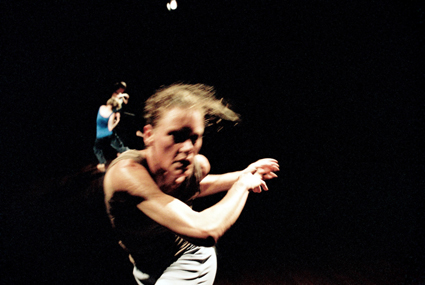
dance
photo Heidrun Löhr
dance
d a n s e is a project that Rosalind Crisp has been developing continuously since 2005 between Australia and France in collaboration with her company and other artists.
The d a n s e project deals with a volatile group of choreographic principles which guide the way movement is produced by the dancer. The practice is not about memorising movements, but rather, about practicing ways of sourcing movement from any part of the body, at any speed or level, with any force or direction, for any duration … at any time. It is about the body dancing.
Three fundamental scores or attention tasks are:
– As soon as one notices the beginnings of an habitual movement pathway, redirect the attention to another part of the body or employ a different speed, direction, size or effort in that movement.
– Practice constantly changing the speed, level, direction, effort or part of the body which is initiating the movement (an impossible task but one which constantly awakens one to the potential of each moment).
– Practice delaying the beginnings of movements or suspending momentarily during a movement. In this brief space one has time to notice, and potentially to make, a different movement choice than the one which was about to be fulfilled.
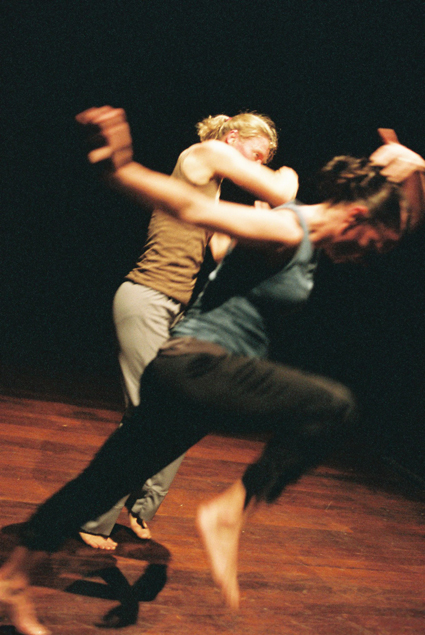
dance
photo Heidrun Löhr
dance
With her attention on how the movements are forming, the dancer is constantly in the present – that is, in the moment of making the movement. Through practice, as the dancer embodies these and many other choreographic scores, they become anchors for her attention, particularly when performing. The scores imprint multiple ways of exploring each moment of the dance. As the dancer’s body awareness becomes myelinated with ways of finding movement in any part of the body, at any speed, level, direction, effort,… at any time, this inevitably informs the way she perceives herself dancing and generates a fluid interactivity between the body and the imaginary, ultimately giving her a lot of freedom to play beyond the rules.
In the beginning I called it ‘not dancing’. Later I realized that this was simply a necessary process of positive discrimination towards movements of lesser ‘value’. Now any-thing is permitted, even ‘presentation’ if it comes along. Everything IS something
‘d a n s e is a modality of work that Rosalind Crisp has been developing since 2005. It is about a way of working with the body and an ensemble of unstable principles which guide the production of movement by the dancer. These principles are continually transforming, constituting a language that is both rigorously identifiable and constantly mutating.
d a n s e is not a piece but a world in constant evolution. This process of work is the basis from which pieces or performances crystallise, reflecting different moments or facets of the process, and which we term ’sites’. Each piece or performance is born of the confrontation between the practice of d a n s e , other artists, a particular space, or a specific question. Each of these meetings carves a new direction for the work, giving the particular form and substance to each site ….’ Isabelle Ginot, dance researcher
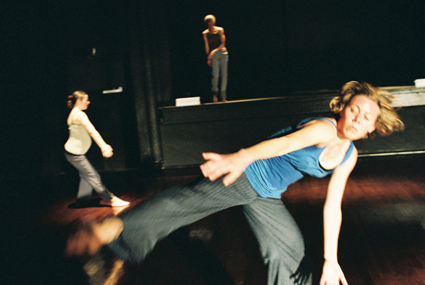
dance
photo Heidrun Löhr
dance
The history of the d a n s e project is inextricably linked with the first performances that emerged from this research. dance was developed in 2005 at Omeo Dance studio in Sydney and presented at Performance Space. It was the first public ‘site’ of this project.
Each dancer independently sustains a fifty minute journey through an open space. Stools are placed throughout the space for the audience. The four dancers work in silence for thirty-eight minutes. This is broken suddenly by loud rock and roll music, for 3 minutes. They keep working, the visceral impact of the music impacting on their dancing, they continue afterwards, again in silence.
‘The structure of this piece is the lightest I could find. It brings the four of us into close proximity at times, without ever addressing directly any harmonious composition of two or more bodies in the same location. The turning point for me in making this work was breaking away from frontal presentation, not a new concept at that time, but something that had not been relevant to my work since the view from here (installation piece for galleries, 2001)’. Rosalind Crisp
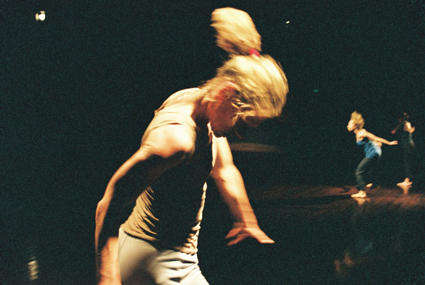
dance
photo Heidrun Löhr
dance
credits: choreographer Rosalind Crisp, dancer/collaborators Lizzie Thomson, Joanna Pollitt, Olivia Millard, Rosalind Crisp, video Eric Pellet, lights/production Simon Wise
performances: Performance Space Sydney November 2005, Dancehouse Melbourne (duet version Lizzie and Rosalind) November 2005
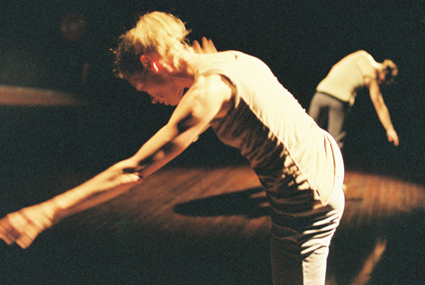
dance
photo Heidrun Löhr
dance
articles/reviews – realtime
movement study, dance magic
eleanor brickhill, realtime 71, february-march, 2006
video
danse (2005) le fresnoy, france
d a n s e from Rosalind Crisp on Vimeo.
This video is the original source material of the d a n s e project
other
the demanding world of rosalind crisp: three points of immersion by a sometime inhabitant
jo pollitt, brolga, december 2006, pp. 23-30
less adds up to more
deborah jones, the australian, november 28, 2005
dance
david corbet, melbourne stage online, december 2005






